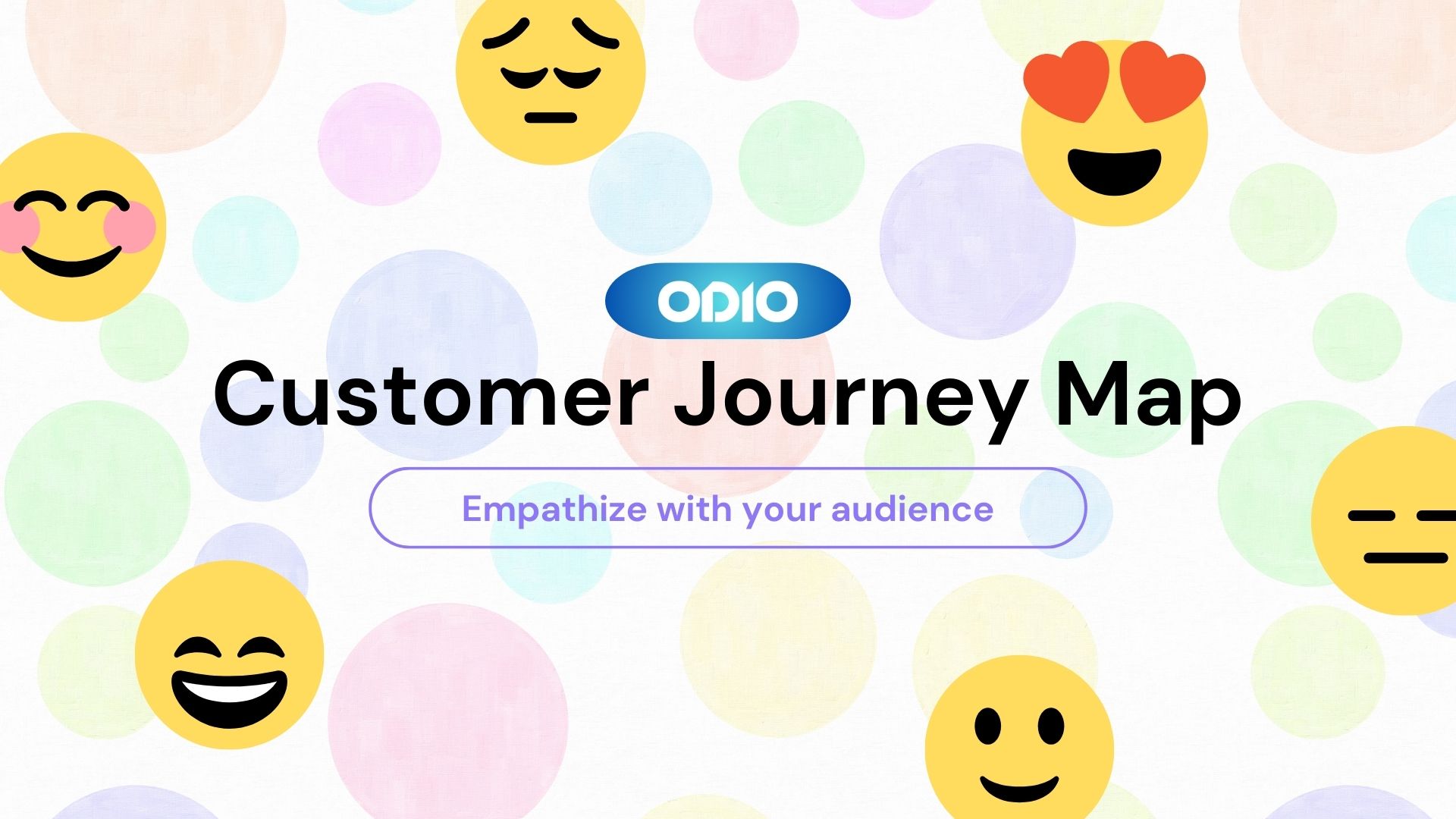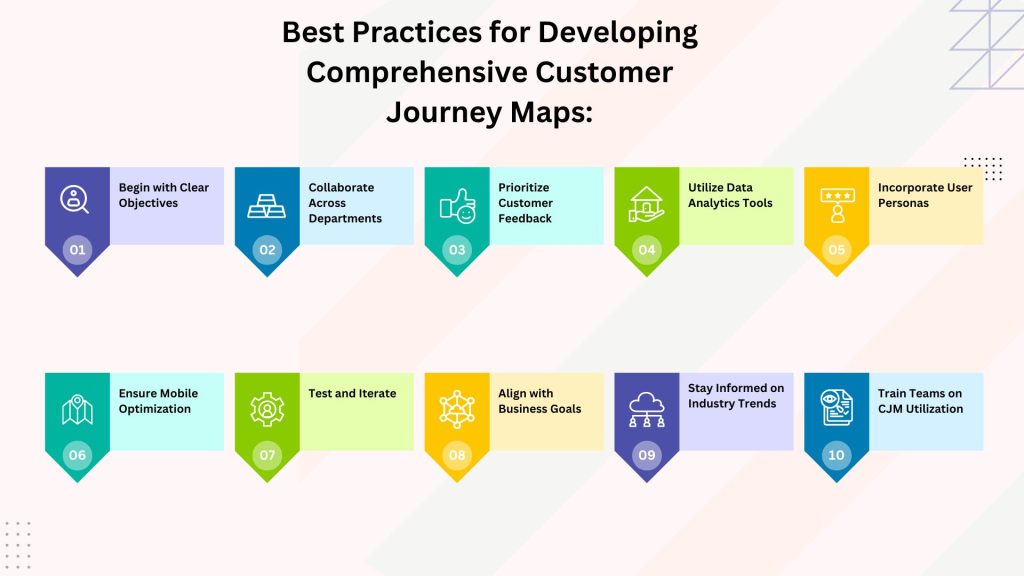
Introduction
In the fast-paced digital landscape, understanding and mastering the art of customer engagement is the key to business triumph. As businesses strive to create memorable experiences for their customers, the role of Customer Journey Mapping (CJM) becomes increasingly pivotal. Albert Einstein once said, “Strive not to be a success, but rather to be of value.” In the realm of customer-centricity, this value is uncovered through the meticulous understanding of customer journeys.
What is Customer Journey Mapping?
At its core, a Customer Journey Map is a visual representation of the various touchpoints a customer encounters while interacting with a brand. It goes beyond a mere diagram; it is a dynamic tool that unveils the customer’s experience from awareness to post-purchase engagement. The purpose is clear – to comprehend, analyze, and optimize each step of the customer’s path, ensuring a seamless and gratifying experience.
Components of a Customer Journey Map
A well-crafted CJM comprises several components, including customer touchpoints, emotions, pain points, and opportunities. It delves into the psyche of the consumer, deciphering their motivations, frustrations, and moments of delight. By incorporating these elements, businesses gain valuable insights into the holistic customer experience.
Why Organizations Use Customer Journey Maps:
Organizations are increasingly turning to CJMs as strategic tools. They offer a holistic view of the customer’s perspective, aiding in the alignment of business strategies with customer expectations. By understanding the customer journey, companies can tailor their offerings, marketing strategies, and customer support, fostering a customer-centric culture.
Importance of Understanding Customer Journeys:
In the era of hyper-connectivity, customers are not just seeking products or services; they are craving meaningful experiences. Understanding customer journeys is not a mere trend; it is a necessity for businesses aiming for sustained success. According to a recent study by Gartner, companies that prioritize customer experience outperform their competitors in terms of revenue by a staggering 16%.
Benefits of Customer Journey Mapping:
As we navigate the complex terrain of business success, the compass that guides us is none other than the Customer Journey Map (CJM). Beyond being a visual representation, a well-crafted CJM serves as a compass, illuminating the path towards enhanced customer experiences and organizational triumphs.
A. Improved Customer Experience:
Customer Experience (CX) is the heartbeat of any successful business. A meticulously designed CJM allows organizations to identify and address pain points, leading to a significant improvement in the overall customer experience. According to a study by McKinsey, companies that prioritize customer experience witness a revenue growth up to 15% more than their counterparts.
B. Enhanced Customer Engagement:
Engagement is the bridge that connects businesses and their customers. Through CJMs, companies can understand the touchpoints that resonate most with their audience, thereby enhancing customer engagement. A well-engaged customer is not just a patron; they become brand advocates, contributing to organic growth.
C. Identification of Pain Points and Opportunities:
No journey is without its challenges, and the customer’s journey is no exception. CJMs act as a diagnostic tool, identifying pain points and uncovering opportunities for refinement. Addressing these pain points can lead to increased customer satisfaction, loyalty, and ultimately, business success.
D. Alignment of Business Strategies:
Strategic alignment is the cornerstone of organizational success. CJMs provide a roadmap for businesses to align their strategies with the expectations and needs of their customers. This synchronization ensures that every action and decision aligns with the overarching goal of delivering exceptional value to customers.
E. Increased Customer Loyalty and Retention:
In a world of endless choices, customer loyalty is a precious commodity. CJMs contribute to fostering loyalty by understanding the customer’s journey and consistently delivering exceptional experiences. According to a report by Harvard Business Review, increasing customer retention rates by 5% can lead to a profit increase of 25% to 95%.
Customer Journey Mapping Process: A Step-by-Step Guide
As we embark on the journey of Customer Journey Mapping (CJM), it’s essential to have a roadmap to navigate the complexities of understanding and enhancing the customer experience. The process is not just a series of steps but a strategic approach to unraveling the intricacies of customer interactions. Buckle up as we guide you through the transformative CJM process.
A. Define Objectives and Scope:
Before setting sail on the CJM voyage, it’s crucial to define the objectives and scope. What specific goals are you aiming to achieve with the CJM? Are you focused on enhancing a particular touchpoint or revamping the entire customer journey? Clarity in objectives sets the tone for a purposeful mapping process.
B. Identify Customer Touchpoints:
Customers interact with your brand at various touchpoints, each contributing to their overall experience. Identify these touchpoints – from initial awareness to post-purchase support. According to a study by Deloitte, companies that actively manage all customer touchpoints can boost customer satisfaction rates by 30%.
C. Gather Customer Data and Insights:
Data is the compass that guides the CJM process. Gather quantitative and qualitative data to gain insights into customer behavior, preferences, and pain points. Analytics tools, customer feedback, and surveys can provide a wealth of information to inform your mapping journey.
D. Create Customer Personas:
Personas breathe life into the CJM. Develop detailed customer personas based on the collected data. These personas represent archetypal customers, helping you empathize with their needs, desires, and challenges. A well-crafted persona ensures a more accurate and personalized mapping process.
E. Map Customer Journey Stages:
Segment the customer journey into distinct stages, from awareness to advocacy. Visualize the progression of customer interactions at each stage. This step is pivotal in creating a holistic map that captures the entire journey, providing a comprehensive view for analysis.
F. Analyze and Identify Pain Points:
With the journey mapped, analyze each stage to pinpoint pain points – moments where customers may encounter friction or dissatisfaction. Understanding these pain points is essential for developing effective solutions and optimizing the overall experience.
G. Design Solutions and Enhancements:
Armed with insights, design solutions to address identified pain points and enhance positive touchpoints. Collaborate across departments to implement changes that align with your overall business objectives and customer expectations.
H. Implement and Monitor Changes:
The journey doesn’t end with designing solutions; it extends to implementation and continuous monitoring. Implement the changes and monitor their impact on customer experience. Regularly revisit the CJM to adapt to evolving customer expectations and market dynamics.
Types of Customer Journey Maps:
In the vast landscape of customer experience optimization, Customer Journey Mapping (CJM) takes on various forms, each offering unique perspectives and applications. Let’s delve into the diverse types of CJMs, shedding light on their specific characteristics and advantages.
A. Current-State Journey Maps:
Current-state journey maps provide a snapshot of the existing customer journey, portraying the current interactions, touchpoints, and pain points. This type is foundational, serving as a baseline for organizations to identify areas of improvement and optimization.
B. Future-State Journey Maps:
While current-state maps focus on the present, future-state journey maps envision the ideal customer journey after implementing planned improvements. These maps act as a guide for organizations, helping them visualize and strategize for an enhanced future customer experience.
C. Day-in-the-Life Journey Maps:
For a more immersive understanding, day-in-the-life journey maps detail a customer’s daily experiences, both within and outside the brand interactions. This type provides insights into the broader context of a customer’s life, facilitating more personalized and contextualized experiences.
D. Service Blueprints:
Service blueprints expand beyond customer interactions to encompass the internal processes and resources required to deliver a seamless customer experience. This type aligns organizational operations with customer touchpoints, ensuring a synchronized and efficient service delivery.
E. Channel-Specific Journey Maps:
In the digital age, customers engage with brands through various channels. Channel-specific journey maps focus on a particular platform or interaction channel, such as a website, mobile app, or social media. This type ensures optimization for specific customer touchpoints.
Examples of Common Customer Journey Map Templates:
A. Linear Customer Journey Map:
Linear maps represent the customer journey in a linear fashion, guiding through a step-by-step progression of touchpoints. This template is ideal for visualizing straightforward customer interactions, providing a clear and easy-to-follow narrative.
B. Circular Customer Journey Map:
Circular maps present the customer journey as a continuous loop, emphasizing the cyclical nature of interactions. This template is beneficial for highlighting recurring customer engagement patterns and ongoing relationships.
C. Swimlane Customer Journey Map:
Swimlane maps categorize touchpoints based on different business departments or stages, offering a visual representation of organizational involvement in the customer journey. This template aids in understanding the collaboration required across departments.
D. Experience Flowchart:
Experience flowcharts use symbols and arrows to depict the flow of customer interactions. This template is useful for illustrating decision points, branch paths, and key touchpoints in a systematic manner.
E. Impact-Effort Matrix:
An impact-effort matrix evaluates the impact of proposed changes against the effort required for implementation. This template assists organizations in prioritizing enhancements based on their potential for positive customer impact and feasibility of execution.
Real-world Use Cases of Customer Journey Mapping:
Embarking on the journey of Customer Journey Mapping (CJM) isn’t just a theoretical exercise; it’s a transformative practice that has yielded remarkable results for organizations across diverse industries. Let’s explore real-world use cases where CJMs have played a pivotal role in elevating customer experiences.
A. E-commerce: Enhancing the Online Shopping Experience
In the competitive realm of e-commerce, understanding and optimizing the customer journey is paramount. Leading online retailers leverage CJMs to identify friction points in the purchasing process, personalize recommendations, and streamline the overall online shopping experience. As a result, they witness higher customer satisfaction, increased conversions, and improved brand loyalty.
B. Healthcare: Improving Patient Journey and Satisfaction
The healthcare industry is embracing CJMs to enhance patient experiences at every touchpoint – from scheduling appointments to post-treatment follow-ups. By mapping the patient journey, healthcare providers identify areas for improved communication, reduced wait times, and increased patient satisfaction. The result is a more patient-centric approach that contributes to better health outcomes and stronger patient-provider relationships.
C. Financial Services: Streamlining Banking and Investment Processes
In the financial services sector, CJMs are employed to streamline complex processes such as account opening, loan approvals, and investment management. By mapping the customer journey, financial institutions identify bottlenecks, improve communication, and provide personalized financial guidance. The result is a more efficient and customer-friendly financial experience, fostering trust and loyalty.
D. Hospitality: Elevating the Guest Experience in Hotels
Luxury hotels and resorts utilize CJMs to craft seamless and memorable guest experiences. From booking accommodations to post-stay feedback, mapping the guest journey allows hospitality providers to anticipate needs, personalize services, and address pain points. This meticulous approach contributes to positive reviews, repeat bookings, and a stellar reputation in the competitive hospitality industry.
E. SaaS: Optimizing the User Onboarding and Support Journey
Software as a Service (SaaS) companies leverage CJMs to optimize the user journey, particularly during onboarding and ongoing support. By mapping the user experience, SaaS providers identify areas for user education, personalized onboarding processes, and efficient support systems. This leads to higher user retention, reduced churn rates, and increased customer lifetime value.
Best Practices for Developing Comprehensive Customer Journey Maps:
As we navigate the ever-evolving landscape of Customer Journey Mapping (CJM), it’s essential to establish best practices that ensure the creation of comprehensive and effective maps. Let’s delve into key strategies that organizations can adopt to shape the future of their customer experiences.
1. Begin with Clear Objectives:
Before embarking on the CJM journey, define clear objectives. Whether it’s improving specific touchpoints, enhancing overall customer satisfaction, or optimizing conversion rates, having well-defined goals provides direction and purpose to the mapping process.
2. Collaborate Across Departments:
Customer journeys often span multiple departments within an organization. Collaborate with teams from marketing, sales, customer service, and beyond to gain a holistic understanding of the customer experience. This collaborative approach ensures that CJMs accurately represent the end-to-end journey.
3. Prioritize Customer Feedback:
Customer feedback is a valuable resource in shaping CJMs. Actively collect and analyze customer input through surveys, reviews, and direct interactions. This firsthand information provides insights into customer perceptions, pain points, and expectations, serving as a foundation for mapping improvements.
4. Utilize Data Analytics Tools:
Data analytics tools play a crucial role in identifying patterns, trends, and correlations within customer data. Leverage these tools to gather quantitative insights that complement qualitative information. The synergy between data analytics and customer feedback ensures a comprehensive and data-driven approach to CJM.
5. Incorporate User Personas:
User personas breathe life into CJMs by representing archetypal customers with distinct needs and preferences. Develop detailed personas based on demographics, behaviors, and motivations. This human-centric approach ensures that CJMs resonate with the diverse range of customers your organization serves.
6. Ensure Mobile Optimization:
In an era dominated by mobile devices, it’s crucial to ensure that CJMs consider the unique challenges and opportunities presented by mobile interactions. Optimize touchpoints and user journeys for mobile users, recognizing the increasing prevalence of on-the-go customer interactions.
7. Test and Iterate:
Customer journeys are dynamic, evolving alongside market trends and consumer behavior. Implement a culture of continuous improvement by testing CJMs, monitoring their impact, and iterating based on insights. This iterative process ensures that maps remain relevant and effective over time.
8. Align with Business Goals:
Every CJM should align with overarching business goals. Whether it’s increasing revenue, improving customer loyalty, or expanding market share, the mapped customer journey should contribute directly to the achievement of strategic objectives. This alignment ensures that CJMs become integral tools for organizational success.
9. Stay Informed on Industry Trends:
The landscape of customer experience is continually shaped by industry trends. Stay informed on emerging technologies, consumer behaviors, and market dynamics. Anticipate future trends in CJM, ensuring that your maps remain at the forefront of customer-centric practices.
10. Train Teams on CJM Utilization:
The effectiveness of CJMs is maximized when teams across the organization understand and utilize them. Provide training sessions to ensure that employees comprehend the value of CJMs and can actively contribute to the optimization of customer touchpoints.

Future Trends in Customer Journey Mapping: AI Integration and Beyond
As we stand at the crossroads of technological advancement and customer-centric innovation, the future of Customer Journey Mapping (CJM) holds exciting possibilities. Let’s explore the emerging trends that are set to shape the next frontier of CJM, propelling businesses toward unprecedented levels of customer understanding and engagement.
A. Integration of Artificial Intelligence:
Artificial Intelligence (AI) is set to revolutionize CJM by introducing advanced capabilities for data analysis, pattern recognition, and predictive modeling. AI algorithms will not only enhance the efficiency of mapping processes but also enable real-time adaptation to evolving customer behaviors. The integration of AI ensures that CJMs remain agile, responsive, and highly accurate.
B. Predictive Analytics in Customer Journey Mapping:
The future of CJM involves harnessing the power of predictive analytics to foresee customer behaviors and preferences. By analyzing historical data and patterns, organizations can proactively design experiences that align with the evolving expectations of customers. Predictive analytics adds a layer of foresight to CJMs, enabling businesses to stay ahead in the dynamic landscape of customer experience.
C. Personalization and Hyper-Personalization:
AI-driven personalization is poised to redefine how organizations approach CJM. Beyond segment-based mapping, hyper-personalization will take center stage, tailoring experiences on an individual level. The ability to dynamically adjust touchpoints and interactions based on real-time data ensures that each customer’s journey is unique and optimized for maximum satisfaction.
D. Automation of Journey Mapping Processes:
The future envisions a seamless and efficient CJM process through increased automation. AI-powered tools will streamline data collection, analysis, and map creation, allowing organizations to focus on strategic decision-making rather than manual tasks. Automation ensures that CJMs are not only accurate but also delivered in a timely manner to meet the pace of business demands.
E. Real-time Adaptation and Continuous Improvement:
The evolving landscape of customer interactions demands real-time adaptation and continuous improvement. Future CJMs will be dynamic, responding to changing customer behaviors and market trends in real-time. This agility ensures that organizations can make instant adjustments to their strategies, fostering a culture of constant enhancement and optimization.
F. Ecosystem Integration for Holistic Mapping:
The future of CJM extends beyond organizational silos. Integrating the entire customer ecosystem, including partners, vendors, and external platforms, will provide a more holistic view of the customer journey. This collaborative approach ensures that CJMs accurately represent the multifaceted interactions customers have across various touchpoints.
G. Enhanced Visualization Technologies:
Advanced visualization technologies, such as virtual and augmented reality, will play a role in shaping the future of CJM. These technologies offer immersive experiences, allowing organizations to simulate and visualize customer journeys in innovative ways. This enhanced visualization fosters a deeper understanding of customer interactions and pain points.
H. Ethical Use of Customer Data:
As CJM becomes more sophisticated, organizations must prioritize the ethical use of customer data. Respecting privacy, transparency in data collection, and ensuring compliance with data protection regulations will be integral to building and maintaining customer trust. Ethical considerations will shape the future landscape of CJM practices.
I. Integration of Emotional Analytics:
Beyond traditional data points, the future of CJM involves the integration of emotional analytics. AI algorithms will analyze customer sentiments, emotions, and reactions at different touchpoints. Understanding the emotional journey provides organizations with valuable insights to create experiences that resonate on a deeper level.
Conclusion
As we conclude this exploration of Customer Journey Mapping, it’s evident that the future is rich with possibilities. The integration of AI, predictive analytics, and advanced technologies will propel CJM into new realms of sophistication and effectiveness. Organizations that embrace these future trends will navigate the next horizon of customer experience with precision and innovation.
What trends do you foresee shaping the future of Customer Journey Mapping? Share your thoughts and predictions in the comments below.
Thank you for joining us on this journey through the realms of AI and cost-effective call center strategies. For more insightful content, stay tuned to our blogs at Odio.

